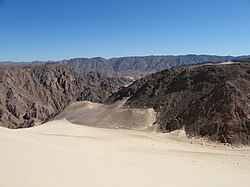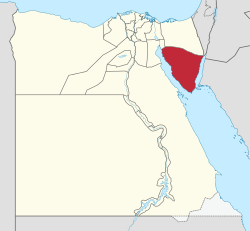South Sinai Governorate (Arabic: محافظة جنوب سيناء Muḥāfaẓah Ganūb Sīnāʾ) is the least populated governorate of Egypt. It is located in the east of the country, encompassing the southern half of the Sinai Peninsula. Saint Catherine's Monastery, an Eastern Orthodox Church monastery and UNESCO World Heritage Site of world renown, is located in the central part of the governorate.
South Sinai Governorate | |
|---|---|
 Landscape in South Sinai governorate | |
 South Sinai Governorate on the map of Egypt | |
| Coordinates: 29°03′N 33°50′E / 29.05°N 33.83°E | |
| Country | |
| Seat | El Tor (capital) |
| Government | |
| • Governor | Khaled Fouda Saddiq Mohammed[1] |
| Area | |
| • Total | 33,140 km2 (12,800 sq mi) |
| Population (January 2024)[2] | |
| • Total | 117,113 |
| • Density | 3.5/km2 (9.2/sq mi) |
| GDP | |
| • Total | EGP 58 billion (US$ 3.7 billion) |
| Time zone | UTC+2 (EET) |
| ISO 3166 code | EG-JS |
| HDI (2021) | 0.738[4] high · 10th |
| Website | www |
Municipal divisions
editThe governorate is divided into the following municipal divisions for administrative purposes with a total estimated population as of January 2023 of 117,113.[2]
| Anglicized name | Native name | Arabic transliteration | Area km² |
Population (January 2023 Est.) |
Type |
|---|---|---|---|---|---|
| Abu Redis (incl. Abu Zenima) | قسم أبو رديس | Abū Radīs incl. Abū Zanīmah | 6,637 | 12,535 | Kism (urban and rural parts) |
| Dahab | قسم دهب | Dahab | 1,083 | 3,156 | Kism (urban and rural parts) |
| El Tor | قسم الطور | Aṭ-Ṭūr | 2,581 | 45,449 | Kism (urban and rural parts) |
| Nuweiba | قسم نويبع | Nuwaybi'a | 4,852 | 7,713 | Kism (urban and rural parts) |
| Ras Sedr | قسم رأس سدر | Ras Sidr | 6,781 | 17,932 | Kism (urban and rural parts) |
| Saint Catherine | قسم سانت كاترين | Sānt Kātirīn | 5,883 | 4,863 | Kism (urban and rural parts) |
| Sharm El Sheikh 1 | قسم أول شرم الشيخ | Sharm ash-Shaykh 1 | 45 | 13,616 | Kism (fully urban) |
| Sharm El Sheikh 2 | قسم ثان شرم الشيخ | Sharm ash-Shaykh 2 | 1,378 | 1,445 | Kism (urban and rural parts) |
| Taba | قسم طابا | Ṭābā | 96 | 814 | Kism (fully rural) |
| South Sinai Governorate | جنوب سيناء | Muḥāfaẓah Ganūb Sīnāʾv | 31.272 | 115.611 | 8 Kism |
Tourism
editThe governorate is an attractive destination for tourism due to its amazing and fascinating nature scenes; however, it has been the site of several terrorist attacks. In 1985, a mass murder occurred in the Ras Burqa resort and killed 8 people (7 Israeli tourists and 1 Egyptian policeman). The 2004 Sinai bombings that targeted tourist hotels in and around Nuweiba killed 34 people and wounded over 170. In 2005, Sharm El Sheikh was hit by a terrorist attack. 88 people were killed, the majority of them Egyptians, and over 200 were wounded, at that time making it the deadliest terrorist action in the country's history (exceeding the Luxor massacre of 1997, which killed 62 people).[5] 2006 saw the Dahab bombings, which killed 23 people and wounded 80.
The Sinai insurgency, although happening mainly in the neighboring North Sinai Governorate, has occasionally spilled over to South Sinai. In February 2014, a tourist bus was attacked in Taba. The perpetrators killed the Egyptian bus driver and three South Korean tourists.
After 2014, The Egyptian government and the Egyptian army took firm actions to eliminate terrorism, and now the city is quite safe.
Demographics
editAccording to population estimates, in 2024 the majority of residents in the governorate lived in urban areas, with an urbanization rate of 51.1%. Out of an estimated 117,113 people residing in the governorate, 59,845 people lived in urban areas as opposed to only 57,268 in rural areas.[6] The Bedouin inhabit the Mount Sinai area. Due to poor accessibility, at times the orchards in the mountains have served to hide narcotics smugglers in the region.[7]
Landmarks
editSaint Catherine's Monastery, an Eastern Orthodox Church monastery and UNESCO World Heritage Site of world renown, is located in central part of the governorate, at the mouth of a gorge at the foot of Mount Sinai, in the city of Saint Catherine, Egypt. Built between 548 and 565, the monastery is one of the oldest working Christian monasteries in the world.[8] The site contains the world's oldest continually operating library, possessing many unique books including the Syriac Sinaiticus and, until 1859, the Codex Sinaiticus.[9][10]
Raithu Monastery is situated in El Tor. It was built on a site where some 40 monks were massacred in the 4th or 5th century.[11]
Cities and towns
editSites
editReferences
edit- ^ "رسمياً.. المحافظون الجدد ونوابهم يؤدون اليمين الدستورية أمام الرئيس". Almasry Alyoum (in Arabic). 30 August 2018. Archived from the original on 31 August 2018. Retrieved 31 August 2018.
- ^ a b "ﻋـــﺩﺩ ﺍﻟﺳﻛــﺎﻥ ﺍﻟﺗﻘﺩﻳﺭﻯ ﻟﻸﻗﺳــﺎﻡ" [Estimated population number of sections] (PDF). www.capmas.gov.eg (in Arabic). 2023. Archived (PDF) from the original on 3 April 2023. Retrieved 4 July 2023.
- ^ "GDP BY GOVERNORATE". mped.gov.eg.
- ^ "Sub-national HDI - Subnational HDI - Table - Global Data Lab". globaldatalab.org. Retrieved 20 February 2023.
- ^ "Bombers kill 88 at Egyptian resort". The Guardian. 23 July 2005. Archived from the original on 16 August 2016. Retrieved 7 November 2016.
- ^ "Population Estimates By Sex & Governorate 1/1/2015" (PDF). CAPMAS. Archived (PDF) from the original on 19 October 2015. Retrieved 23 October 2016.
- ^ Marx, Emanuel (30 June 2013). Bedouin of Mount Sinai: An Anthropological Study of their Political Economy. Berghahn Books. p. 74. ISBN 978-0-85745-932-9.
- ^ "Saint Catherine Area". UNESCO. Archived from the original on 17 November 2016. Retrieved 7 November 2016.
- ^ Schrope, Mark (1 June 2015). "Medicine's Hidden Roots in an Ancient Manuscript". NY Times. Archived from the original on 1 June 2015. Retrieved 1 June 2015.
- ^ Jules Leroy; Peter Collin (2004). Monks and Monasteries of the Near East. Gorgias Press LLC. pp. 93–94. ISBN 978-1-59333-276-1.
- ^ El-Din, Morsi Saad; Taher, Ayman; Romano, Luciano (1 February 1998). Sinai: The Site & the History : Essays. NYU Press. p. 114. ISBN 978-0-8147-2203-9. Retrieved 7 November 2016.

